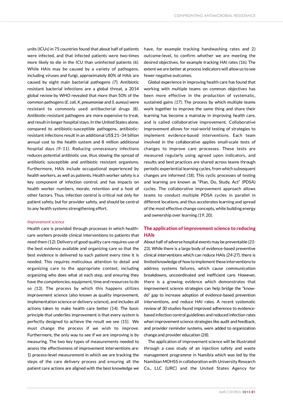
units (ICUs) in 75 countries found that about half of patients
were infected, and that infected patients were two-times
more likely to die in the ICU than uninfected patients (6).
While HAIs may be caused by a variety of pathogens,
including viruses and fungi, approximately 80% of HAIs are
caused by eight main bacterial pathogens (7). Antibiotic
resistant bacterial infections are a global threat, a 2014
global review by WHO revealed that more than 50% of the
common pathogens (E. coli, K. pneumoniae and S. aureus) were
resistant to commonly used antibacterial drugs (8).
Antibiotic-resistant pathogens are more expensive to treat,
and result in longer hospital stays. In the United States alone,
compared to antibiotic-susceptible pathogens, antibioticresistant
infections result in an additional US$ 21-34 billion
annual cost to the health system and 8 million additional
hospital days (9-11). Reducing unnecessary infections
reduces potential antibiotic use, thus slowing the spread of
antibiotic susceptible and antibiotic resistant organisms.
Furthermore, HAIs include occupational experienced by
health workers, as well as patients. Health worker safety is a
key component of infection control, and has impacts on
health worker numbers, morale, retention and a host of
other factors. Thus, infection control is critical not only for
patient safety, but for provider safety, and should be central
to any health systems strengthening effort.
Improvement science
Health care is provided through processes in which healthcare
workers provide clinical interventions to patients that
need them (12). Delivery of good quality care requires use of
the best evidence available and organizing care so that the
best evidence is delivered to each patient every time it is
needed. This requires meticulous attention to detail and
organizing care to the appropriate context, including
organizing who does what at each step, and ensuring they
have the competencies, equipment, time and resources to do
so (13). The process by which this happens utilizes
improvement science (also known as quality improvement,
implementation science or delivery science), and includes all
actions taken to make health care better (14). The basic
principle that underlies improvement is that every system is
perfectly designed to achieve the result we see (15). We
must change the process if we wish to improve.
Furthermore, the only way to see if we are improving is by
measuring. The two key types of measurements needed to
assess the effectiveness of improvement interventions are:
1) process-level measurement in which we are tracking the
steps of the care delivery process and ensuring all the
patient care actions are aligned with the best knowledge we
have, for example tracking handwashing rates and 2)
outcome-level, to confirm whether we are meeting the
desired objectives, for example tracking HAI rates (16). The
extent we are better at process indicators will allow us to see
fewer negative outcomes.
Global experience in improving health care has found that
working with multiple teams on common objectives has
been more effective in the production of systematic,
sustained gains (17). The process by which multiple teams
work together to improve the same thing and share their
learning has become a mainstay in improving health care,
and is called collaborative improvement. Collaborative
improvement allows for real-world testing of strategies to
implement evidence-based interventions. Each team
involved in the collaborative applies small-scale tests of
changes to improve care processes. These tests are
measured regularly using agreed upon indicators, and
results and best practices are shared across teams through
periodic experiential learning cycles, from which subsequent
changes are informed (18). This cyclic processes of testing
and learning are known as "Plan, Do, Study, Act" (PDSA)
cycles. The collaborative improvement approach allows
teams to conduct multiple PDSA cycles in parallel in
different locations, and thus accelerates learning and spread
of the most effective change concepts, while building energy
and ownership over learning (19, 20).
The application of improvement science to reducing
HAIs
About half of adverse hospital events may be preventable (2123).
While there is a large body of evidence-based preventive
clinical interventions which can reduce HAIs (24-27), there is
limited knowledge of how to implement these interventions to
address systems failures, which cause communication
breakdowns, uncoordinated and inefficient care. However,
there is a growing evidence which demonstrates that
improvement science strategies can help bridge the "knowdo"
gap to increase adoption of evidence-based prevention
interventions, and reduce HAI rates. A recent systematic
review of 30 studies found improved adherence to evidencebased
infection control guidelines and reduced infection rates
when improvement science strategies like audit and feedback,
and provider reminder systems, were added to organization
change and provider education (28).
The application of improvement science will be illustrated
through a case study of an injection safety and waste
management programme in Namibia which was led by the
Namibian MOHSS in collaboration with University Research
Co., LLC (URC) and the United States Agency for
CONFRONTING ANTIMICROBIAL RESISTANCE
AMR CONTROL 2015 81